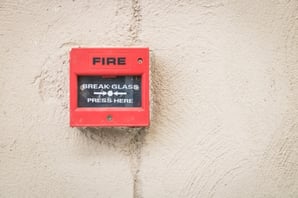Ensuring Fire Safety: Understanding Fire Safety Notices and Total Fire Protection
 Fire safety is a crucial aspect of building management and the protection of human lives. In any environment, whether it's a residential complex, commercial building, or public facility, the implementation of effective fire safety measures is paramount. One essential component of fire safety is the proper display and understanding of fire safety notices. In this blog post, we will delve into the significance of fire safety notices and explore the concept of Total Fire Protection (TFP) as a comprehensive approach to safeguarding against fire hazards.
Fire safety is a crucial aspect of building management and the protection of human lives. In any environment, whether it's a residential complex, commercial building, or public facility, the implementation of effective fire safety measures is paramount. One essential component of fire safety is the proper display and understanding of fire safety notices. In this blog post, we will delve into the significance of fire safety notices and explore the concept of Total Fire Protection (TFP) as a comprehensive approach to safeguarding against fire hazards.
Importance of Fire Safety Notices
Fire safety notices serve as vital communication tools that inform and educate individuals about potential fire risks and necessary actions to take in case of an emergency. These notices are typically displayed in visible locations within buildings and provide crucial information to occupants and visitors. Fire safety notices can vary in content and format, but they often include essential elements, such as fire exit routes, emergency contact information, fire assembly points, and instructions for operating firefighting equipment.
Fire safety notices are designed to enhance awareness, improve response times during emergencies, and minimize panic. They play a fundamental role in enabling individuals to make informed decisions and take appropriate actions to protect themselves and others. By clearly displaying fire safety notices, building owners and managers fulfill their responsibility of providing a safe environment for occupants and visitors.
Understanding TFP
TFP is a comprehensive fire safety approach that goes beyond the minimum legal requirements. It encompasses various fire protection measures and aims to create a safe environment by reducing fire risks, enhancing detection and alarm systems, implementing fire suppression measures, and promoting evacuation procedures. TFP integrates both passive and active fire protection measures to ensure a multi-layered approach to fire safety.
Passive fire protection measures involve the design and construction of buildings to minimize the spread of fire, smoke, and toxic gasses. This includes fire-resistant building materials, compartmentalization, fire-rated doors and windows, and adequate ventilation systems. These measures help contain a fire, limit its spread, and provide safe evacuation routes for occupants.
Active fire protection measures involve systems and equipment designed to detect, control, and suppress fires. This includes fire detection and alarm systems, automatic sprinkler systems, fire extinguishers, and emergency lighting. These measures are crucial in providing early warning, suppressing fires, and facilitating safe evacuation.
Implementing TFP
To implement TFP effectively, building owners and managers should consider the following steps:
1. Conduct a comprehensive fire risk assessment: Identify potential fire hazards, evaluate existing fire safety measures, and determine areas that require improvement.
2. Install and maintain fire safety equipment: Ensure the installation and regular maintenance of fire detection and alarm systems, automatic sprinklers, fire extinguishers, and emergency lighting.
3. Develop and communicate emergency plans: Establish clear emergency response plans, including evacuation procedures, assembly points, and communication channels. Regularly communicate these plans to all occupants and conduct fire drills periodically.
4. Display clear and informative fire safety notices: Place fire safety notices in visible locations throughout the building. Ensure notices are up-to-date, easily readable, and comply with relevant regulations.
5. Provide fire safety training: Educate building occupants about fire prevention, the proper use of firefighting equipment, and the actions to take in case of a fire emergency. Regular training sessions help raise awareness and promote a proactive fire safety culture.
Fire safety notices and TFP are integral components of creating a safe environment for building occupants and visitors. By understanding the importance of fire safety notices and implementing TFP measures, building owners and managers can significantly reduce fire risks, enhance emergency response capabilities, and protect lives and property.
Contact us today to get started on your next project. With Compass Group as your partner, we will ensure your building has fire safety notices and TFP to provide the utmost protection to both people and the property.
Photo by Srattha Nualsate
Topics: regulations, safety
